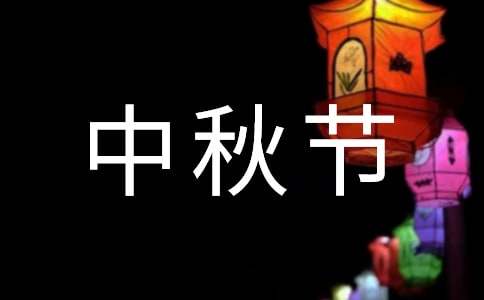关于中秋节英语资料
中秋节是流行于中国众多民族与汉字文化圈诸国的传统文化节日,时在农历八月十五;因其恰值三秋之半,故名,也有些地方将中秋节定在八月十六。下面小编给大家带来关于中秋节英语资料,欢迎大家阅读。

关于中秋节英语资料1
In ancient times the "On the eve of Autumn Twilight" practices. On the eve of that worship Goddess. Set large incense table, put the moon cake, watermelons, apples, dates, plums, grapes other offerings, moon cake and watermelon is definitely not small. Also cut into the lotus-shaped watermelon. Under the month, the moon god on the moon that direction, Candle high burning the whole family followed by worship the moon, then the charge of the housewife cut happy moon cake. Pre-cut people who count the number of good family, at home, in the field should count together, can not cut more and no cut less the same size.
古代有“秋暮夕月”的习俗。夕月,即祭拜月神。设大香案,摆上月饼、西瓜、苹果、红枣、李子、葡萄等祭品,其中月饼和西瓜是绝对不能少的。西瓜还要切成莲花状。在月下,将月亮神像放在月亮的那个方向,红烛高燃,全家人依次拜祭月亮,然后由当家主妇切开团圆月饼。切的人预先算好全家共有多少人,在家的,在外地的,都要算在一起,不能切多也不能切少,大小要一样。
关于中秋节英语资料2
The Mid-Autumn Festival falls on the 15th day of the 8th lunar month, usually in October in Gregorian calendar.
每年农历八月十五日,是传统的中秋佳节。这时是一年秋季的中期,所以被称为中秋。
The festival has a long history. In ancient China, emperors followed the rite of offering sacrifices to the sun in spring and to the moon in autumn. Historical books of the Zhou Dynasty had had the word "Mid-Autumn". Later aristocrats and literary figures helped expand the ceremony to common people. They enjoyed the full, bright moon on that day, worshipped it and expressed their thoughts and feelings under it. By the Tang Dynasty (618-907), the Mid-Autumn Festival had been fixed, which became even grander in the Song Dynasty (960-1279). In the Ming (1368-1644) and Qing (1644-1911) dynasties, it grew to be a major festival of China.
中秋节有悠久的历史,和其它传统节日一样,也是慢慢发展形成的`,古代帝王有春天祭日,秋天祭月的礼制,早在《周礼》一书中,已有“中秋”一词的记载。后来贵族和文人学士也仿效起来,在中秋时节,对着天上又亮又圆一轮皓月,观赏祭拜,寄托情怀,这种习俗就这样传到民间,形成一个传统的活动,一直到了唐代,这种祭月的风俗更为人们重视,中秋节才成为固定的节日,《唐书·太宗记》记载有“八月十五中秋节”,这个节日盛行于宋朝,至明清时,已与元旦齐名,成为我国的主要节日之一。
Folklore about the origin of the festival go like this: In remote antiquity, there were ten suns rising in the sky, which scorched all crops and drove people into dire poverty. A hero named Hou Yi was much worried about this, he ascended to the top of the Kunlun Mountain and, directing his superhuman strength to full extent, drew his extraordinary bow and shot down the nine superfluous suns one after another. He also ordered the last sun to rise and set according to time. For this reason, he was respected and loved by the people and lots of people of ideals and integrity came to him to learn martial arts from him. A person named Peng Meng lurked in them.
相传,远古时候天上有十日同时出现,晒得庄稼枯死,民不聊生,一个名叫后羿的英雄,力大无穷,他同情受苦的百姓,登上昆仑山顶,运足神力,拉开神弓,一气射下九个多太阳,并严令最后一个太阳按时起落,为民造福。后羿因此受到百姓的尊敬和爱戴,不少志士慕名前来投师学艺,心术不正的蓬蒙也混了进来。
关于中秋节英语资料3
The introduction of the Mid-Autumn Day:
"Zhong Qiu Jie", which is also known as the Mid-Autumn Festival, is celebrated on the 15th day of the 8th month of the lunar calendar. It is a time for family members and loved ones to congregate and enjoy the full moon - an auspicious symbol of abundance, harmony and luck. Adults will usually indulge in fragrant mooncakes of many varieties with a good cup of piping hot Chinese tea, while the little ones run around with their brightly-lit lanterns.
"Zhong Qiu Jie" probably began as a harvest festival. The festival was later given a mythological flavour with legends of Chang-E, the beautiful lady in the moon.
According to Chinese mythology, the earth once had 10 suns circling over it. One day, all 10 suns appeared together, scorching the earth with their heat. The earth was saved when a strong archer, Hou Yi, succeeded in shooting down 9 of the suns. Yi stole the elixir of life to save the people from his tyrannical rule, but his wife, Chang-E drank it. Thus started the legend of the lady in the moon to whom young Chinese girls would pray at the Mid-Autumn Festival.
In the 14th century, the eating of mooncakes at "Zhong Qiu Jie" was given a new significance. The story goes that when Zhu Yuan Zhang was plotting to overthrow the Yuan Dynasty started by the Mongolians, the rebels hid their messages in the Mid-Autumn mooncakes. Zhong Qiu Jie is hence also a commemoration of the overthrow of the Mongolians by the Han people.
During the Yuan Dynasty (A.D.1206-1368) China was ruled by the Mongolian people. Leaders from the preceding Sung Dynasty(A.D.960-1279) were unhappy at submitting to foreign rule, and set how to coordinate the rebellion without it being discovered. The leaders of the rebellion, knowing that the Moon Festival was drawing near, ordered the making of special cakes. Packed into each mooncake was a message with the outline of the attack. On the night of the Moon Festival, the rebels successfully attacked and overthrew the government. What followed was the establishment of the Ming Dynasty (A.D. 1368-1644). Today, moon cakes are eaten to commemorate this event.
Mid-Autumn Day is a traditional festival in China. Almost everyone likes to eat mooncakes on that day. Most families have a dinner together to celebrate the festival. A saying goes, "The moon in your hometown is almost always the brightest and roundest". Many people who live far away from homes want to go back to have a family reunion. How happy it is to enjoy the moon cakes while watching the full moon with your family members.
关于中秋节英语资料4
Mid-autumn day中秋节
lunar农历
mooncake月饼
minimooncake 迷你月饼
mooncakes with meat / nuts 肉馅/果仁月饼
ham mooncake火腿月饼
grapefruit / pomelo / shaddock 柚子
glue pudding汤圆
lantern / scaldfish灯笼
Chang E 嫦娥
Hou Yi 后羿
light lantern 点灯笼
carry the lantern around提灯笼
burn incense 烧香
fire dragon dances火龙舞
family reunion家庭团聚 / 圆
【关于中秋节英语资料】相关文章:
关于职称英语考试的相关资料01-25
考研英语阅读资料必看12-29
考研英语的听力资料05-17
英语面试英文面试资料06-13
职称英语复习资料11-14
中秋节猜灯谜资料(通用5篇)09-30
有关于英语名人名言手抄报资料12-29
资料员英语简历范文08-21
考研复试笔试英语资料05-17
考研复试英语口语资料12-01